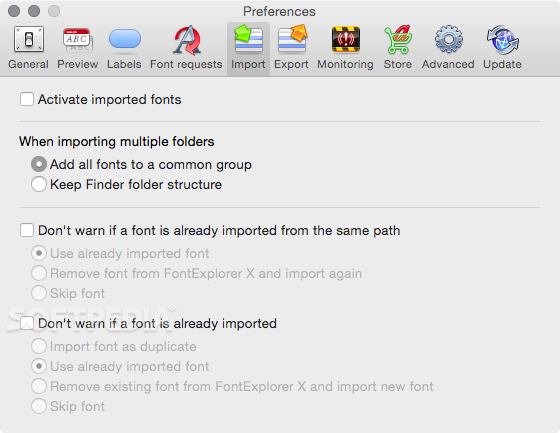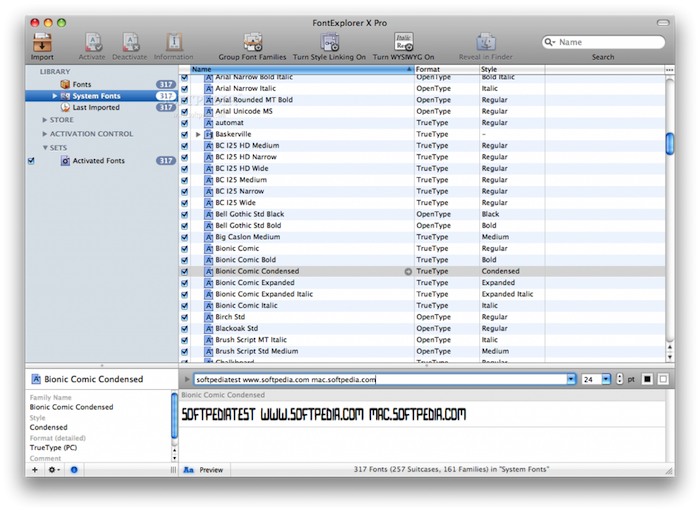- Linotype Fontexplorer X Mac Free Download
- Linotype Fontexplorer X Pro 3.0 Mac Download Free
- Font Explorer
FontExplorer X for Mac OS. Professional font management in Mac OS. Apple Applications. Integrated font management in Mac OS. Windows Applications. Integrated font management in Windows. The Know How section offers detailed background knowledge to deal with all enquiries about the use of fonts. Open FontExplorer X Pro. Go to the “FontExplorer X Pro” Menu. Select “Preferences”. Select the “Advanced” entry. If it is not already selected, check the “Organize font files” entry. Select if you want to copy or move all your fonts to the “FontExplorer Pro” folder.
To improve your productivity further, Linotype FontExplorer X comes with integration plug-ins for some of the most popular digital publishing suites, such as Adobe InDesign, Adobe Illustrator, or QuarkXPress. We at AppsForMyPC have tested and used Linotype FontExplorer X for Mac and it worked pretty smoothly 🙂 🙂. Download Palatino Linotype font for PC/Mac for free, take a test-drive and see the entire character set. Moreover, you can embed it to your website with @font-face support. Download the latest version of FontExplorer X for Mac. Font manager with online purchases. The iTunes of fonts is called Linotype FontExplorer X, a font manager.



Download FontExplorer X Pro 7 for Mac full version software setup free. FontExplorer X Pro 7 for Mac OS X is a professional font management program that gives users complete control to manage all types of fonts. Linotype FontExplorer X Pro 4 Crack Free Download (Win & Mac) you cancel or downgrade your paid membership, you will Linotype FontExplorer X Pro 4 Crack Free Download (Win & Mac) still have access to all of the files in the Creative Cloud folder on your computer and via the Creative Cloud website. Your account will be downgraded to a free. Installing your fonts on a Mac system System requirements: Mac OS 10 We at Linotype recommend using the OpenType font format. Among the major advantages of this format is that it provides for compatibility between Mac and Windows and allows up to 65,000 characters per font to be embedded.

The Mergenthaler Linotype Company is a corporation founded in the United States in 1886 to market the Linotype machine (/ˈlaɪnəˌtaɪp,-noʊ-/), a system to cast metal type in lines (linecaster) invented by Ottmar Mergenthaler. It became the world's leading manufacturer of book and newspaper typesetting equipment; outside North America, its only serious challenger for book production was the Anglo-American Monotype Corporation. It also offered phototypesetting and digital products before being taken over by Monotype Imaging in 2006. Since March 2013, its legal name has been changed to Monotype GmbH.
Founding[edit]
The invention of a machine to replace the labor-intensive task of setting type by hand had been tackled by many inventors during the 19th century. The most time consumed was not in creating the text, but in returning the characters to their proper position for future use. Mergenthaler solved this problem by placing a type mold for a letter on the side of a specially keyed matrix (with multiple matrix/molds available for any given letter). The linotype operator would type in a line of text. The machine would drop each matrix with its mold into place, assembling the matrices into a line of text that was needed. Hot lead alloy was then forced into the molds of matrices, creating the fresh line of type.
The linotype operator would then go on to type in the next line. Multiple lines would be stacked into blocks, sometimes paragraphs, to be set in place in the proper column of the page layout. Samba client for mac. Meanwhile, back inside the linotype machine, the matrices used for a line would progress through the machine, where the special keying system on one end of the matrix, unique for each character, would allow the matrix to drop back only into the correct storage slot, ready for the next use. Another benefit of this overall process was that each edition of the paper was created from a fresh casting of metal, thus avoiding problems of type wear.
Another problem Mergenthaler solved was in justifying the type, or ensuring that in a column of print, there were flush margins on the left and right. Hand compositors had previously done this by using spaces of different widths in a line, to ensure that the lines all ended at the same point. Mergenthaler adapted the 'space band' (patented by J. W. Schuckers), a device consisting of two wedges of metal connected loosely. When a line of type was being justified, all the space band wedges would be pushed up in two passes[clarification needed] to spread the line out to the full measure being cast. The space bands were stored for reuse in a different location from the matrices.
History[edit]
The invention of the first working Linotype was a long, arduous and intricate process that involved many players and the creation of a long succession of companies.
In 1877, the National Printing Company was organized under the laws of the District of Columbia and Lewis Clephane, the brother of James O. Clephane, was elected president.[1] After the first successful trial of the Linotype in October, 1885, the Merganthaler Printing Company was established to raise fresh capital from the shareholders of the National Printing Company.[2]. Finally, The Merganthaler Linotype Company was formed in New York in 1895.[3] Philip Tell Dodge served as its first president until 1928 when his son Norman Dodge replaced him.[4]
In 1889 The Linotype Company, a British offshoot of the firm, was formed by Joseph Lawrence, publisher of The Railway Magazine. In 1899, a new factory in Broadheath, Altrincham was opened. In 1903, the British company merged with Machinery Trust to form Linotype & Machinery Ltd.
Mergenthaler Linotype dominated the printing industry through the twentieth century. The machines were so well designed, major parts remained virtually unchanged for nearly 100 years.[5] A particularly notable success was Linotype's Legibility Group of typefaces, used by most of the world's (Latin-alphabet) newspapers for much of the twentieth century.[6][7][8] The ruggedness of the Linotype system, which cast lines as solid bars of type, aided this dominance.
Linotype Company was merged with Merganthaler acquisition K. S. Paul to form Linotype-Paul Ltd which developed a range of Linotron phototypesetters using K. S. Paul's cathode ray tube technology.[9]
The company, as so many in the printing industry, endured a complex post-war history, during which printing technology went through two revolutions — first moving to phototypesetting, then to digital.
Linotype Formula
During the 1950s, the Davidson Corporation, which manufactured a series of small offset presses, was a subsidiary of Linotype. This was later sold to American Type Founders and operated under the name ATF-Davidson.[10]
Through a series of mergers and reorganizations, the business of Mergenthaler Linotype Company ultimately vested in Linotype-Hell AG, a German company. In April 1997, Linotype-Hell AG was acquired by Heidelberger Druckmaschinen AG. The following month certain divisions of Linotype-Hell AG were spun off into new companies, one of which was Linotype Library GmbH with headquarters at Bad Homburg vor der Höhe. This new company was responsible solely for the acquisition, creation and distribution of digital fonts and related software. This spin-off effectively divorced the company's font software business from the older typesetting business which was retained by Heidelberg. In 2005, Linotype Library GmbH shortened its name to Linotype GmbH, and in 2007, Linotype GmbH was acquired by Monotype Imaging Holdings, Inc., the parent of Monotype Imaging, Inc. and others.
Typefaces[edit]
The typefaces in the Linotype type library are the artwork of some of the most famous typeface designers of the 20th century. The library contains such famous trademarked typefaces as Palatino and Optima by Hermann Zapf; Frutiger, Avenir and Univers by Adrian Frutiger; and Helvetica by Max Miedinger and Eduard Hoffman. Linotype GmbH frequently brings out new designs from both established and new type designers. Linotype has also introduced FontExplorer X for Mac OS X. It is a well-reviewed font manager that allows users to browse and purchase new fonts within the program — a business model similar to that used by iTunes and the iTunes Store.
The simplified Arabic typeface Yakout, named for the 13th-century Islamic calligrapherYaqut al-Musta'simi,[11] was released by Linotype in 1956, and remains one of the most common Arabic typefaces for books and newspapers.[12]
See also[edit]
References[edit]

Linotype Fontexplorer X Mac Free Download
- ^Romano, Frank (2014). History of the Linotype Company. RIT Press. p. 10. ISBN978-1-933360-60-7.
- ^Romano, Frank (2014). History of the Linotype Company. RIT Press. p. 18. ISBN978-1-933360-60-7.
- ^Romano, Frank (2014). History of the Linotype Company. RIT Press. p. 50. ISBN978-1-933360-60-7.
- ^Romano, Frank (2014). History of the Linotype Company. RIT Press. p. 288. ISBN978-1-933360-60-7.
- ^Howells, John; Dearman, Marion (1996). Tramp Printers (1st ed.). Los Angeles: Discovery Press. p. 280. ISBN978-0-9650979-0-1.
- ^Hutt, Allen (1973). The Changing Newspaper: typographic trends in Britain and America 1622-1972 (1. publ. ed.). London: Fraser. pp. 100–2 etc. ISBN9780900406225.
The majority of the world's newspapers are typeset in one or another of the traditional Linotype 'Legibility Group', and most of the rest in their derivatives.
- ^Alexander S. Lawson (January 1990). Anatomy of a Typeface. David R. Godine Publisher. pp. 277–294. ISBN978-0-87923-333-4.
- ^The Legibility of Type. Brooklyn: Mergenthaler Linotype Company. 1935.
- ^https://www.gxpress.net/derek-kyte-uk-pioneer-of-crt-typesetting-dies-at-90-cms-10813
- ^'Davidson Dual-Lith advertisement'. Graphic Arts Monthly. September 1955.
- ^Nemeth, Titus (2017). Arabic Type-Making in the Machine Age: The Influence of Technology on the Form of Arabic Type, 1908–1993. BRILL. ISBN9789004349308.
- ^Rhodes, Margaret (23 October 2015). 'Why It's So Hard to Design Arabic Typefaces'. Wired. ISSN1059-1028. OCLC300118412.
Linotype Fontexplorer X For Mac
Further reading[edit]
- Manfred Raether: „Linotype – Chronik eines Firmennamens“; E-Book, self-published, Schöneck 2009
- Basil Kahan: Ottmar Mergenthaler – The Man and his Machine; Oak Knoll Press, New Castle (DE), 2000 – ISBN1-58456-007-X
- 1919 new model machine, acquired by the Abbeville Herald (Alabama) for US$3,000.
External links[edit]
- Linotype – Chronik eines Firmennamens (Linotype – Chronologie of a Company Name): e-book covering the history of Linotype, starting in 1886
- The Linotype & Machinery Co. Ltd - information sheet on the UK company from the Museum of Science and Industry (Manchester)
- Chauncey Hawley Griffith papers at the University of Kentucky (Mergenthaler's Vice President for Typographic Development)